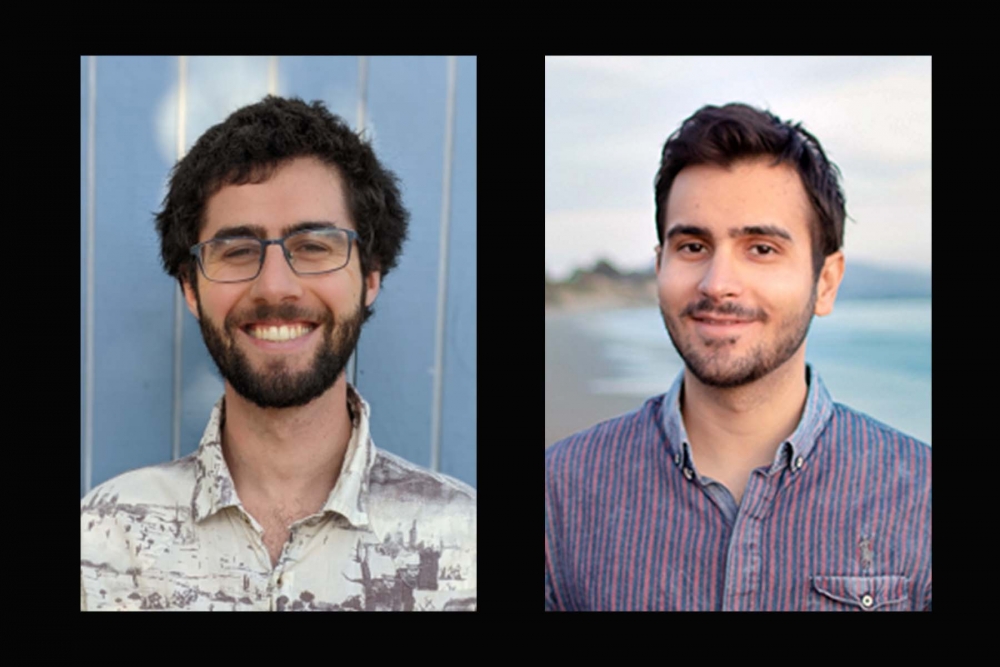
Priority Projects
Two UC Santa Barbara graduate students in the College of Engineering have received opportunities to conduct research at prestigious national laboratories operated by the U.S. Department of Energy (DOE). Eli Zoghlin and Kamyar Parto are among 65 students nationwide selected to participate in the DOE’s Office of Science Graduate Student Research (SCGSR) program. The fellowship provides funding to the awardees as they collaborate with established scientists at one of the agency’s fourteen national laboratories.
Zoghlin, a sixth-year materials Ph.D. student who is advised by materials professor Stephen Wilson, investigates crystal growth and the characterization of fundamentally interesting magnetic and electronic materials. He will work with Matt Stone, who operates an instrument called SEQUOIA in the Spallation Neutron Source (SNS) at the Oak Ridge National Laboratory (ORNL) in Tennessee.
“Academically, this fellowship could not have come at a better time,” said Zoghlin, who plans to complete his doctoral degree next fall. “Working with Matt Stone, who is an expert in neutron scattering, is a fantastic opportunity for me to improve my mastery of a technique that can only be carried out at dedicated facilities like ORNL. While a lot can be learned from books, there is nothing like hands-on experience to truly learn how to carry out an experiment.”
During the height of the pandemic, travel restrictions limited opportunities for outside researchers to conduct high-value experiments at national labs, and as a result, delayed collection of data central for publications.
“This DOE fellowship provides me the opportunity to make up for that and work directly with Matt on my own experiment and others,” added Zoghlin, who received a bachelor’s degree in materials science and engineering from Carnegie Mellon University. “I hope to carry out several publishable experiments to complete my last project as a graduate student and begin writing my thesis.”
His research project, “Study of the Structure and Dynamics of Li2TMO2 (TM = Cu, Ni) via Neutron Scattering,” will investigate two magnetic materials, dilithium copper oxygen (Li2CuO2) and dilithium nickel oxygen (Li2NiO2). These materials are structurally very similar — meaning their periodic arrangement of atoms is the same — with both having one-dimensional chains of copper (Cu)/nickel (Ni) ions that are well separated from each other. The difference between the materials lies in the intrinsic magnetic properties of Cu and Ni, which is what Zoghlin plans to investigate. He will take materials that he is currently synthesizing in the Wilson lab to the SNS, where he will use the neutrons produced there for his research project. Neutrons, the subatomic particle found in the nucleus of all atoms, interact with magnetic materials in well-defined ways and, with a technique known as neutron scattering, can be used to understand certain properties.
“By studying how neutrons scatter off the two materials, I will learn what type of magnetic order they each show and how the interactions between the Cu/Ni atoms lead to that order,” explained Zoghlin, who is scheduled to conduct his research at the national lab for three months, starting in January 2022. “This is fundamental research at its finest.”
Parto, a third-year electrical and computer engineering Ph.D. student, was selected to study quantum light sources, an important step in the push to design small and scalable quantum computers that function at room temperatures. Co-advised by electrical and computer engineering faculty members Kaustav Banerjee and Galan Moody, Parto will work with Han Htoon in the Center for Integrated Nanotechnologies (CINT) at the Los Alamos National Laboratory in New Mexico.
“Dr. Htoon is one of the pioneers in this field, and his expertise, combined with the state-of-the-art implantation facilities, provide an ideal setting for a researcher,” said Parto, who joined the Ph.D. program after completing the master’s program at UCSB. “The journey of my Ph.D. has been filled with periods of self-doubt and questioning of my own methods, but this recognition has provided an immeasurable morale and motivational boost.”
Parto studies and characterizes defect complexes in transition metal dichalcogenides (TMDs) for application in quantum light generation and quantum computing. TMDs are two-dimensional (2D), atomically thin materials that show unique electrical, mechanical and optical properties. TMDs can contain a number of structural defects in their crystal lattices, which significantly alter their properties. Studying defects allows researchers to eliminate unfavorable defects and introduce beneficial ones to realize higher-performing materials and technologies.
Recently, researchers learned that some structural imperfections in TMDs can be triggered to emit a single photon, one at a time. This type of light, called quantum light, is a vital building block for quantum photonics circuits. For his project, “Engineering and Characterization of Quantum Defects in 2D TMDs,” Parto will engineer these defects at the atomic level and characterize their quantum light emission.
“My work aims to address one of the major bottlenecks in the field by finding the right quantum light source that can be integrated with the current photonics technology platform,” explained Parto, who received his bachelor’s degree in engineering science - electronics with a minor in computational sciences from the University of Tehran, Iran.
Results from his project could lead to the development and application of efficient and scalable sources of quantum light.
The DOE selected projects that strongly align with priority mission areas of the Office of Science that have a high need for workforce development. The program is intended to strengthen the pipeline for developing a highly skilled scientific and technological workforce by providing new graduate research opportunities at DOE national laboratories. Since 2014, the SCGSR program has provided supplemental funding to nearly 800 U.S. graduate awardees from 153.



